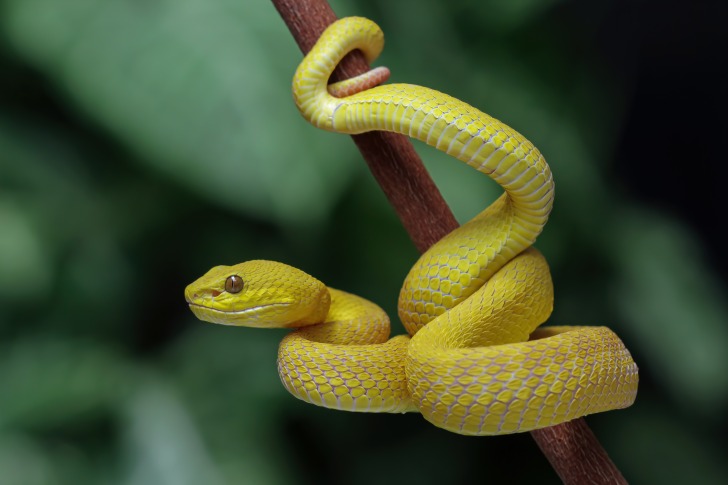Snakes are the stuff of legends, and sometimes, nightmares.
You probably know that they are an essential part of most ecosystems, but that doesn’t stop your pulse from pounding when you think about them.
Contents
So… Are There Snakes in Ohio?
Yes, there are snakes in Ohio. The state has 25 native species, and a total of 33 species are currently found in the state.
However, they aren’t particularly common.
Several species are endangered, including two of Ohio’s venomous snakes.

Snake Species in Ohio
Ohio has 25 species of native snake, but we’ll take a look at a few of the ones you should know.
Nonvenomous Snakes in Ohio
There are many nonvenomous snake species in Ohio.
One of the most common is the gray rat snake.
This is the most common snake in the state.
It’s also the longest, with a thin and long body.
Dekay’s brown snake is next on the list.
These are very common throughout the Eastern U.S., but they aren’t seen very often.
They tend to hide during the day and hunt at night.
They are also small, reaching about 1 foot in length.
The largest brown snakes may be 18 inches long.
The Eastern Gartersnake is one of the most commonly seen snakes in Ohio.
They can be identified by the three yellow or white stripes on their back.
It’s thought they get their name because their stripes look like the garters used to hold women’s stockings.
They aren’t as shy as some other species, and don’t mind making their home near humans.
The northern water snake is another Ohio serpent you may encounter.
These snakes are often mistaken for the venomous copperhead or water moccasin.
As their name suggests, these snakes live near water and can be found in or near ponds, lakes, rivers, and streams.
You may see them in the water, or basking on the bank.
Timber Rattler
The timber rattler is the most common venomous snake in Ohio.
It has a brown or grayish body, with a stripe that runs down its back.
The stripe can be orange, yellow, or black.
They also have a darker chevron pattern that runs down their body.
These snakes have a triangular-shaped head, and a rattle on their tail.
They are typically found in the woods.
However, they have a wide range of habitats, including agricultural fields, marshes, swamps, and river floodplains.
They are responsible for many bites each year, but most aren’t aggressive.
They use their tail as a warning alarm.
If you don’t heed the warning, they may strike.
They are large, growing up to 5 feet long.
They can strike up to 1/2 their body length, so you should keep your distance if you see one.
Eastern Massasauga Rattlesnake
The Eastern Massasauga Rattlesnake is a bit smaller than the timber rattler.
They also sport a rattle at the end of their tail, and a large triangular head.
They make their home in marshes and swamps.
They are less venomous than the timber rattler but still pack an unpleasant punch.
Northern Copperhead
As their name suggests, copperheads typically have a copper-colored head.
Their body is copper, tan, or light gray, with darker brown bands that go down their body.
They also have a triangular-shaped head, but it’s less pronounced than a rattlesnake’s.
They are prevalent in Southeastern Ohio.
They prefer rocky areas, but can also be found in abandoned buildings.
They reach about 3 feet in length.
Copperheads are shy snakes and tend to freeze around humans.
Unfortunately, their camouflage means you can easily step on one, which will prompt a bite.
Is it Safe to Go on a Trek in Ohio?
Ohio’s natural habitats aren’t particularly dangerous, but there are some risks you should be aware of before heading out.
Are Snakes in Ohio Dangerous?
There are 3 types of venomous snakes in Ohio, but your risk of encountering them is pretty rare.
An average of 9 to 15 people die in the U.S. each year due to snakebites.
So, fatalities due to snake bites in Ohio are very rare.
However, one reason for this low number is that snake bites are rarely fatal today.
Nearly 3,000 people are bitten by copperheads in the U.S. each year, but only .01% of them are fatal.
This means copperheads are responsible for one death every 4 years or so.
Rattlesnakes are more common, with about 8,000 bites each year.
Still, there are only 10 to 15 deaths due to rattlesnake bites yearly.
In short, your odds of dying from a snake bite in Ohio are nearly nonexistent.
The chances you’ll get bitten are much higher, but still relatively low.
You can feel safe going on a trek in Ohio, as long as you take some basic precautions.
Other Natural Hazards in Ohio
Snakes aren’t the only thing you need to worry about when exploring in Ohio.
You’ll also need to look out for venomous spiders.
The black widow has a very dangerous, and in some cases, fatal, bite.
The brown recluse can also cause serious damage.
If you frequent Ohios lakes and rivers, you may encounter snapping turtles.
These turtles have a fierce bite, and can easily take off a finger or two.
Other dangerous Ohio natives include coyotes, wolves, bobcats, and wild boar.
Surprisingly, white-tail deer cause the most injuries in the Buckeye state.
This isn’t because they attack humans.
Instead, they are responsible for many car accidents each year.
This is no reason to avoid Ohio’s beautiful natural habitats.
However, it is important to use common sense and avoid interacting with wildlife.
Some animals should be enjoyed from a distance.
Interesting Snake Facts in Ohio
Both the timber and eastern massauga rattler are endangered in Ohio, and throughout much of the country.
Despite most humans’ natural fear of these snakes, we are a bigger threat to them than they are to us.
Timber rattlers are the most venomous snakes currently found in Ohio.
There are rumors of cottonmouths, or water moccasins, in the state, but this has not been officially confirmed.

3 Safety Tips for Exploring Nature in Ohio
- Do your research: Before you head to an area, you should research it well. Learn about the local wildlife, and what should be avoided in the area. You should also have a clear idea of any trails or areas you plan to explore.
- Let someone know where you are: You should always let someone know where you will be, and when you are expected to be back. If they don’t hear from you, your contact person should contact the authorities.
- Protect yourself from plants and parasites: Insect repellants are essential when exploring Ohio because ticks and mosquitoes can carry diseases. Long sleeves and pants can protect you from other issues, like poison ivy.
Summary
Ohio has lots of natural lands to discover and explore.
There are some dangerous snakes in Ohio, but encounters aren’t common.
If you do run into a snake, keep your distance and it will leave you alone.
Ohio Safety Overview
READ THE FULL REPORT: Ohio Safety Review
Safety Index:
- OVERALL RISK: LOW
- TRANSPORT & TAXIS RISK: LOW
- PICKPOCKETS RISK: LOW
- NATURAL DISASTERS RISK: MEDIUM
- MUGGING RISK: LOW
- TERRORISM RISK: LOW
- SCAMS RISK: LOW
- WOMEN TRAVELERS RISK: LOW
Frequently Asked Questions
Are snakes a problem in Ohio?
Snakes aren’t generally a problem in Ohio.
Most aren’t venomous.
However, you should use caution when encountering any type of snake.
What is the most common snake in Ohio?
The gray rat snake is the most common in Ohio.
Can nonvenomous snakes bite?
Yes.
Larger nonvenomous snakes can give you a nasty bite.
Use caution if you handle any snake.











